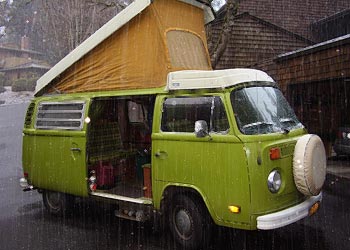I drive my car in the winter and I'm going to make this mod later this week when I change out my wheels to studded tires(!). There was some discussion awhile ago about using SCEET hose (expensive, but very heat resistant and has a smooth lining for bettern air flow) as well as using 2 1/2 to 2" exhaust reducers to join the ducting to the plastic hose that runs alongside the pan to the front of the car. It should improve the defog/defrosting capability if nothing else.
My recollection is that Dr. Clock highly recommended moving the heater outlets to the tunnel and running the heat through it by cutting two holes in the horseshoes, then welding to accept the hoses from the heat exchangers and reinforce the holes a bit. It seems to me that running the heat through the inside of the car should provide for less heat loss. I just can't weld worth anything and the solution Troy talks about is basically plug and play.
The big problem is that hopped-up beetle engines take a lot longer to warm up to operating temps in sub-freezing temperatures, even with the proper flaps & thermostat setup (which most non-stock engines seem to lack). In addition, the exhaust configuration on the replicas sacrifices a source of heat that the beetles used to use. I believe that later models of stock beetles funnelled the air from the fan shroud through mini-preheat boxes that encircled the 2nd and 4th cylinders' exhaust pipes. Those boxes had outlets that connected to the big heat exchangers (which transfer heat from the 1st and 3rd cylinders). It's this inlet on the big heat exchangers to which the hoses on our replicas are usually connected.
Keep in mind that gas heaters were a dealer item for beetles and kombis in far northern climates. There's a reason for this. Even the stock engines when new and in optimum shape simply did not push out a lot of heat in freezing weather, particularly when compared to most of the other cars on the market which had radiators. My parents had a VW van for a number of years when I was growing up in Wisconsin. It didn't have a gas heater and was pretty cool - particularly in the winter.
 (Not the actual van but the same paint and same olive/yellow plaid upholstery)
(Not the actual van but the same paint and same olive/yellow plaid upholstery)
On the plus side, think of a cold car as a built-in safety feature - since the car is basically not much warmer than it is outside you're always prepared if you're stranded!






 (Not the actual van but the same paint and same olive/yellow plaid upholstery)
(Not the actual van but the same paint and same olive/yellow plaid upholstery)